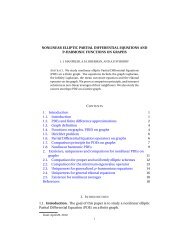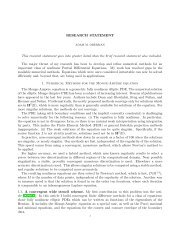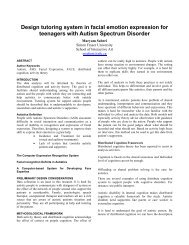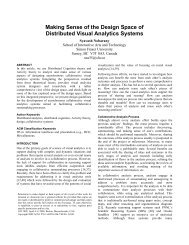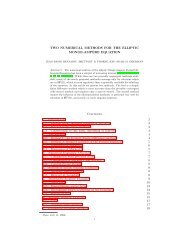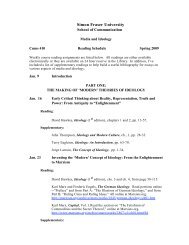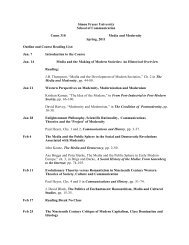Boyd Convex Optimization book - SFU Wiki
Boyd Convex Optimization book - SFU Wiki
Boyd Convex Optimization book - SFU Wiki
Create successful ePaper yourself
Turn your PDF publications into a flip-book with our unique Google optimized e-Paper software.
312 6 Approximation and fitting<br />
Quadratic smoothing<br />
The simplest reconstruction method uses the quadratic smoothing function<br />
n−1<br />
∑<br />
φ quad (x) = (x i+1 − x i ) 2 = ‖Dx‖ 2 2,<br />
where D ∈ R (n−1)×n is the bidiagonal matrix<br />
⎡<br />
⎤<br />
−1 1 0 · · · 0 0 0<br />
0 −1 1 · · · 0 0 0<br />
D =<br />
⎢ .<br />
.<br />
.<br />
.<br />
.<br />
.<br />
.<br />
⎥<br />
⎣ 0 0 0 · · · −1 1 0 ⎦<br />
0 0 0 · · · 0 −1 1<br />
i=1<br />
We can obtain the optimal trade-off between ‖ˆx−x cor ‖ 2 and ‖Dˆx‖ 2 by minimizing<br />
‖ˆx − x cor ‖ 2 2 + δ‖Dˆx‖ 2 2,<br />
where δ > 0 parametrizes the optimal trade-off curve. The solution of this quadratic<br />
problem,<br />
ˆx = (I + δD T D) −1 x cor ,<br />
can be computed very efficiently since I + δD T D is tridiagonal; see appendix C.<br />
Quadratic smoothing example<br />
Figure 6.8 shows a signal x ∈ R 4000 (top) and the corrupted signal x cor (bottom).<br />
The optimal trade-off curve between the objectives ‖ˆx−x cor ‖ 2 and ‖Dˆx‖ 2 is shown<br />
in figure 6.9. The extreme point on the left of the trade-off curve corresponds to<br />
ˆx = x cor , and has objective value ‖Dx cor ‖ 2 = 4.4. The extreme point on the right<br />
corresponds to ˆx = 0, for which ‖ˆx − x cor ‖ 2 = ‖x cor ‖ 2 = 16.2. Note the clear knee<br />
in the trade-off curve near ‖ˆx − x cor ‖ 2 ≈ 3.<br />
Figure 6.10 shows three smoothed signals on the optimal trade-off curve, corresponding<br />
to ‖ˆx − x cor ‖ 2 = 8 (top), 3 (middle), and 1 (bottom). Comparing the<br />
reconstructed signals with the original signal x, we see that the best reconstruction<br />
is obtained for ‖ˆx − x cor ‖ 2 = 3, which corresponds to the knee of the trade-off<br />
curve. For higher values of ‖ˆx − x cor ‖ 2 , there is too much smoothing; for smaller<br />
values there is too little smoothing.<br />
Total variation reconstruction<br />
Simple quadratic smoothing works well as a reconstruction method when the original<br />
signal is very smooth, and the noise is rapidly varying. But any rapid variations<br />
in the original signal will, obviously, be attenuated or removed by quadratic<br />
smoothing. In this section we describe a reconstruction method that can remove<br />
much of the noise, while still preserving occasional rapid variations in the original<br />
signal. The method is based on the smoothing function<br />
n−1<br />
∑<br />
φ tv (ˆx) = |ˆx i+1 − ˆx i | = ‖Dˆx‖ 1 ,<br />
i=1



